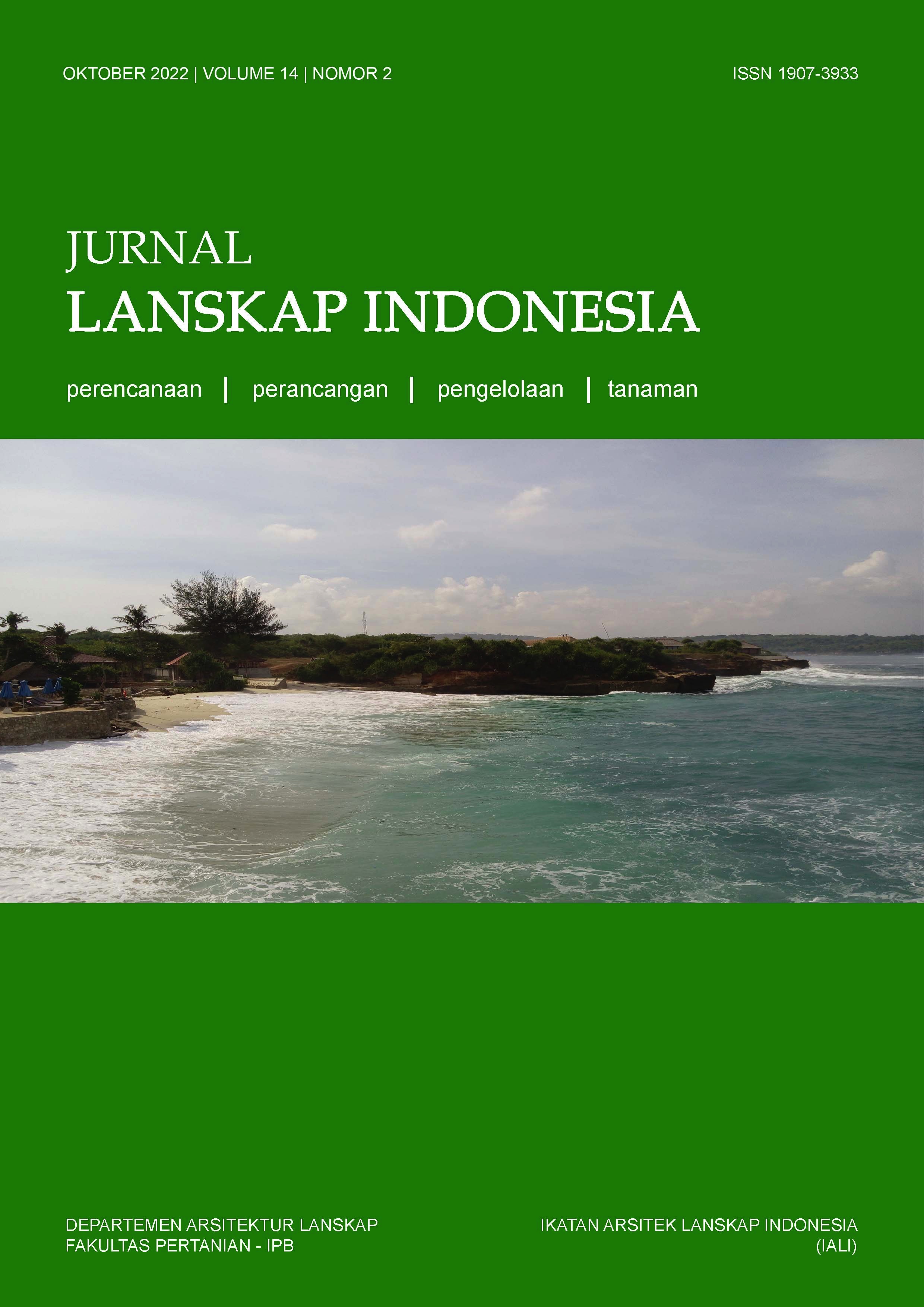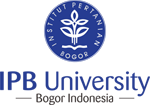Redesain Lanskap Tugu 0 Km Indonesia Melalui Pendekatan Perilaku Manusia Pasca Tsunami di Kota Sabang Provinsi Aceh
Abstract
Sabang City is the western boundary of Indonesia and is known as zero kilometer of Indonesia. Zero Km Monument Indonesia is geographical marker and tourist destination in Sabang City. However, landscape of this monument still has problems, such as less up to date monument, dirty and messy surroundings, deck is less secure, there are disturbance of wild monkeys, and lack of existing facilities. Furthermore, as tsunami affected area, local community demonstrated signs of emotional distress and depressive symptoms. This condition can affect human behaviour in utilizing outdoor space and needs to be considered for further development. The objectives of this study include (1) identifying, analyzing, creating synthesis potentials and constraints and (2) creating concept and redesigning landscape of 0 Km Monument Indonesia. The method used in this study is descriptive and spatial analysis method with field observation, questionnaire, interviews, and literature studies. The main concept of this study is to create a tourist destination that can be used as healing spot in Sabang City. This design concept is bungong jeumpa, a natural element that support healing concept and an iconic symbol that represents to Aceh. It is implemented to design pattern, decoration, and plant. The final result of this research is limited to landscape redesign with the final product that consists of site plan, planting plan, section, and 3D impression.
Downloads
References
Abe, S., Ozawa, M., Kawata, Y. 2019. Science of Societal Safety: Living at Times of Risks and Disasters (p. 227). Springer Nature.
Akbar, M. A. H., Kharis, F. A., Rahmawati, O. P. 2020. Perencanaan Lanskap Mitigasi Tsunami Berbasis Ekosistem Mangrove di Kota Palu. Jurnal Lanskap Indonesia, 12(2), 41-53. https://doi.org/10.29244/jli.v12i2.32383
Basu, M., Hashimoto, S., Dasgupta, R. 2019. The Mediating Role of Place Attachment between Nature Connectedness and Human Well-being: Perspectives from Japan. Sustainability Science 15: 849-862.
Booth, N. K. 1989. Basic elements of Landscape Architectural Design. Waveland press.
Badan Pusat Statistik Kota Sabang. 2019. Kota Sabang Dalam Angka 2019. Sabang: BPS Kota Sabang.
[CDC] Centers for Disease Control and Prevention. 2020. Coronavirus (COVID-19). https://www.cdc.gov/coronavirus/2019-ncov/index.html (diakses 24 Nov 2020).
Coe, S. 2019. Homes, health, and social justice: A role for supporting housing. Conscious Cities Anthology 2019: Science-Informed Architecture and Urbanism. ISSN 2514-6815. https://doi.org/10.33797/CCA19.01.07 .
Effendy, S. 2007. Keterkaitan ruang terbuka hijau dengan urban heat island wilayah Jabodetabek. Skripsi. Institut Pertanian Bogor. Bogor.
Fiala, O. 2017. Natural disasters and Individual behaviour in developing countries. Springer.
Gunn, C. A. 1988. Tourism Planning Second Edition. New York: Taylor & Francis.
Harris, C. W., Dines, N. T. 1988. Time-saver standards for landscape architecture: design and construction data. McGraw-Hill.
Jiang, B., Zhang, T. and Sullivan, W. C. 2015. Healthy cities: Mechanisms and research questions regarding the impacts of urban green landscapes on public health and well-being. Landscape Architecture Frontiers, 3(1).
Karyono, T. H. 2018. Thermal comfort in Indonesia. di Kubota, T, Rijal, H.B., Takaguchi, H (Eds). Sustainable Houses and Living in the Hot-Humid Climates of Asia. Springer. Singapura.
Krishnamurti, T. N., Stefanova, L. and Misra, V. 1979. Tropical meteorology. Secretariat of the World Meteorological Organization.
Musa et al. 2014. Post tsunami psychological impact among survivors in Aceh and West Sumatra, Indonesia. Comprehensive psychiatry, 55.
Ramadhani, E., Rusyana, A. 2010. Correspondence analysis on public service in Sabang Tourism Area. Jurnal Natural 10(1): 36-44.
Rodríguez, H., Donner, W., Trainor, J. E. 2006. Handbook of Disaster Research. New York: Springer.
Rogers, B., Ramirez, D., Marthanty, D. R., Arifin, H. S., Farrelly, M., Fowdar, H., Gunn, A., Holden, J., Kaswanto, R. L., Marino Zamudio, R., McCarthy, D., Novalia, W., Payne, E., Suwarso, R., Syaukat, Y., Urich, C., Wright, A., and Yuliantoro, D. 2019. Leapfrogging Pathways for a Water Sensitive Bogor. Australia-Indonesia Centre (AIC). Monash University.
Souza, R., Bernatsky, S., Reyes, R. and Jong, K. D. 2007. Mental health status of vulnerable tsunami‐affected communities: A survey in Aceh Province, Indonesia. Journal of Traumatic Stress: Official Publication of the International Society for Traumatic Stress Studies, 20(3), pp.263-269.
Tuan, Y. F. T. 1990. A Study of Environmental Perception, Attitudes, and Values. Morning Side Edition. New York: Columbia UP.
Copyright (c) 2022 Ruzeilawati Wasi'atu Lathifah, Dewi Rezalini Anwar

This work is licensed under a Creative Commons Attribution 4.0 International License.
This journal permits and encourages authors to post items submitted to the journal on personal websites or institutional repositories both prior to and after publication, while providing bibliographic details that credit, if applicable, its publication in this journal. However, after the article is submitted and published in this journal, it is fully copyrighted by the Jurnal Lanskap Indonesia or JLI. If excerpts from other copyrighted works are included, the author must obtain written permission from the copyright owner and give credit to the source in the article. Then, the writer or reader is allowed to copy, share, and redistribute articles/material in any form. But it must still include the appropriate source and credit because the article in this journal is licensed by Creative Commons Attribution 4.0 International License (CC BY 4.0).
I. Proposed Policy for Journals That Offer Open Access
Authors who publish with this journal agree to the following terms:
- Authors retain copyright and grant the journal right of first publication with the work simultaneously licensed under a Creative Commons Attribution License that allows others to share the work with an acknowledgement of the work's authorship and initial publication in this journal.
- Authors are able to enter into separate, additional contractual arrangements for the non-exclusive distribution of the journal's published version of the work (e.g., post it to an institutional repository or publish it in a book), with an acknowledgement of its initial publication in this journal.
- Authors are permitted and encouraged to post their work online (e.g., in institutional repositories or on their website) prior to and during the submission process, as it can lead to productive exchanges, as well as earlier and greater citation of published work (See The Effect of Open Access).
II. Proposed Policy for Journals That Offer Delayed Open Access
Authors who publish with this journal agree to the following terms:
- Authors retain copyright and grant the journal right of first publication, with the work after publication simultaneously licensed under a Creative Commons Attribution License that allows others to share the work with an acknowledgement of the work's authorship and initial publication in this journal.
- Authors are able to enter into separate, additional contractual arrangements for the non-exclusive distribution of the journal's published version of the work (e.g., post it to an institutional repository or publish it in a book), with an acknowledgement of its initial publication in this journal.
- Authors are permitted and encouraged to post their work online (e.g., in institutional repositories or on their website) prior to and during the submission process, as it can lead to productive exchanges, as well as earlier and greater citation of published work (See The Effect of Open Access).



























